REPORT FROM SAPMI, FORMERLY KNOWN AS
LAPLAND
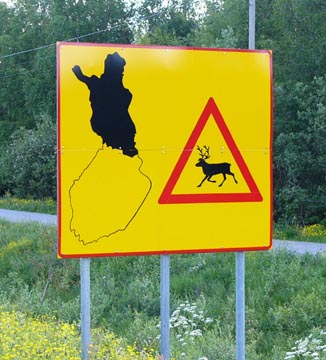

The sign says it; the whole northern reach
of Finland is "reindeer crossing." Or maybe not crossing, maybe just
coming straight down the road with no particular concern for being in
the right lane.
We thought that, being so close, it
would be a shame not
to spend some time above the Arctic Circle. So after our days in
Helsinki, we left on the night train to Rovaniemi. The train that
left
on our track
just
before our train was the “night train to Moscow.” That
sounded like the title
for a movie starring Bogart and Bacall, a good old Cold War movie,
screenplay
by John LeCarre... much more romantic sounding than a night train
to – where?
Rovaniemi: a smallish city about eight kilometers from the Arctic
Circle.
The train was great. We had a sleeper
compartment,
which means a closet-sized roomette with two bunks already made up, an
in-room
toilet which could be turned into a shower (hold the bad jokes,
please), and
next to no place to sit to enjoy the passing scenery, which could be
enjoyed
all night since it is just not getting dark over here these days. It
was an
electric train - all the way. I assumed we would get out of the city
under electric
power
then switch over to diesel, but so far as I could tell, we were under
the
electric wires the whole way. These people have been getting serious
about
living without petroleum. They also seem to maintain their tracks; one
can walk
to the bar car without getting slammed from wall to wall in narrow
corridors.
And it was a good bar car – Lapin Kulta on tap (pints filled all
the way up) –
and tracks so well-maintained that not a drop was slopped.

We got to Rovaniemi around eight
o’clock in the morning,
three minutes late. If you have traveled on Amtrak in America, you
probably
have some understanding of what it means to say the train was only
three
minutes late; usually Amtrak rounds it off its lateness to the nearest
hour on
a good trip, the nearest half-day on a bad trip. This is because in
Europe they
have this radical notion that people come first – before the
freightcar loads
of lumber,
automobiles, grain, coal, whatever, you try to get the people where
they need
to go.
Rovaniemi is a smallish city which
has been
a mining town
and a logging town, and is now one of the tourist gateways to the far
frozen
north. It has attractions ranging from the ridiculous – a Santa
Claus fixation
and a love affair with a hard-rocking madman/monster called Lordi
– to the
sublime: the Arktikum, a wonderful modern museum about life in the
Arctic Zone
around the world.
For those who don’t know, the
Arctic
Circle is a latitudinal
line at 66 degrees, 33 minutes and 7 seconds, above which line the sun
is
visible above the horizon around the clock (provided there’s no
geographic
feature in the way, which there usually is). That is, however, just one
way of
defining the “arctic zone.” Biologists tend to think of it
in terms of
treelines – the point beyond which weather conditions preclude
any life taller
than windbeaten bushes and a lot of tiny plants that took a long time
to even
get tiny. Hydrologists and meteorologists think of the arctic as the
usual
extent of the year-round sea ice, oceanographers in terms of oceanic
currents,
geologists in terms of permafrost, et cetera. Each of those definitions
engenders its own set of boundaries, much more irregular than the
Arctic Circle
– but all under study by someone, we learned at the Arktikum. It
was a good
place to learn as much as you could stand about the greenhouse effect
and what
recent changes in the content of our atmosphere are doing to arctic
regions.
Much of the exhibit space, though,
was given
over to
information about the lives and culture of the native peoples of
Scandinavia’s
arctic region – the people who were called Lapps or Laplanders
when I was in
school, but have now been given the "privilege" of going by their own
name for
themselves, the Sami. All of Finland, Sweden, Norway and some of Russia
north
of the Arctic Circle is Sapmi, the land of the Samis, and they now have
their
own governments – a situation similar to the indigenous peoples
in the US at this point: they get to govern themselves within the
context of the laws of whichever country has included their part of
Sapmi within its boundaries.
We learned – not at the
Arktikum, but
at the Sami’s own
museum the next day, farther north – that this situation was not
always so. A
young woman guide at that museum – she looked about high school
age, and her
English was as good as mine – told us that when her father went
to school,
assimilation was still the national policy, albeit more unconsciously
than aggressively;
Norwegian
and English were the languages taught in the schools then.
But then in the 1980s two large
hydropower
projects were
proposed for the far north, and the Sami people – most of whom
are still
intimately involved with the reindeer, in what now amounts to
"reindeer ranching" – decided they had had enough. There
were
major demonstrations down
in Oslo – sit-ins, teach-ins, people handcuffing themselves to
doors, followed by people beaten on and arrested, but finally
attention
was paid. This was
also a time
when there was a growing international awareness of, and empathy for,
indigenous peoples being overrun elsewhere by our benevolent Western
Civilization.
Between the first and second hydropower dams, major concessions were
made to the Sami people in all the northern countries; in a sense
they
became, or are becoming, a
conscious, and consciously recognized nation unto themselves.
Our young guide said that now the
Sami
languages are the
teaching language in Sapmi schools – not an easy thing, since
there are several
variations on the language, not all intelligible to each other. And
some “blood
money” also seems to have been paid for the dams, and is
apparently still being
paid. In Karasjok, Norway, there is a beautiful Sapmi parliament
building where
representatives from all over Norway gather in an annual congress. This
post,
in fact, is coming from the library attached to the Parliament building
– free
wireless from a library in an indigenous nation above the Arctic Circle
that
until about a century ago, did not even have a written language or
electricity. This is their Parliament building:

Karasjok is
also the location of an interesting, mostly outdoor museum that
portrays the Sami heritage, which is still, with modern modifications,
their
present life. Many of them still spend the summer months out on the
range with their reindeer herds, but they are clearly in the
transition that goes directly from hunting to herding (protecting their
prey from other predators, mostly human) to ranching (working in fenced
ranges, with increasing attention to breeding stock, winter feed
production, and the like). Here are some pictures from the museum:

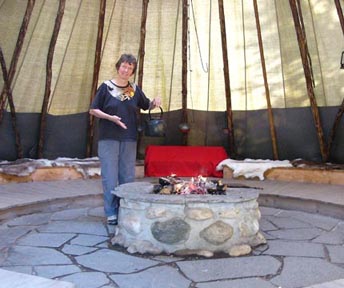
On the left above is a summer "sod tipi"
that is just left in the field, and used for up to 60 years, according
to signage. On the right is a much larger tipi that is taken down and
re-erected every summer. Below is a restaurant building at the museum
that shows the kind of semi-underground, green-roofed construction that
works well in the Arctic - see a modern example below that, in the
lodge we stayed in near Karasjok....
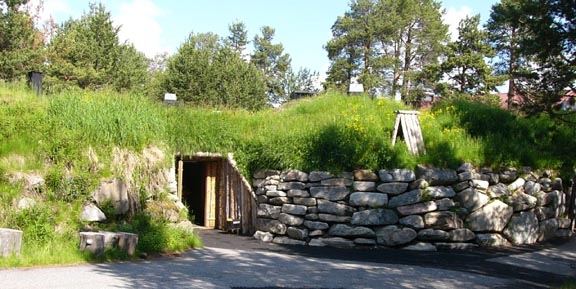

Below are the
scrubby birches common to the Sapmi land above the Arctic Circle. On
the right is one of the high fences that now run through much of the
Sapmi region, dividing the once open range of the Arctic region into
large "reindeer ranches" - a consequence of growing population
pressures in what only a couple generations ago was still a wide-open
herder culture....
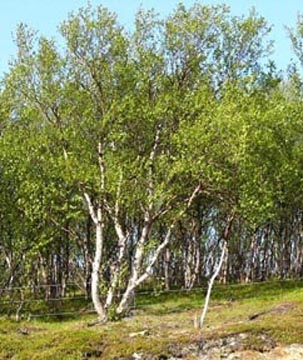
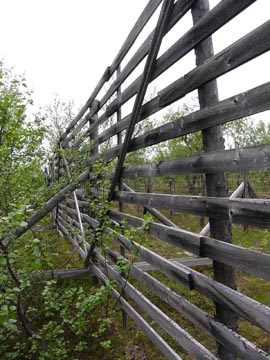
One of the most interesting exhibits
in the
Arktikum museum was a visual presentation of an ongoing study by
anthropologists and other
social
scientists at the University of Lapland, looking at the impacts of
tourism on a
culture that has, until relatively recently, been fairly isolated from
the rest
of the world. In a sense, the Sami had lived in their own universe
until the 20th
century, and are just now becoming aware of themselves as an
interesting
culture that is marketable – so long as it retains its
interesting qualities!
This is, of course the dilemma that all tourism cultures face to some
extent or
another….
Sapmi is beautiful in a subtle and empty
way. There
are long
expanses between towns where not much seems to be going on at all
– kind of
like South Park forever, although a little more lush in its vegetation.
I had expected large unbroken expanses of
boreal
forest – dark spruce and fir – but there was really not
much of that. Pines
that look a lot like our ponderosa (but shorter needles) seem to
dominate the
big-tree forest in “Finnmark” – northernmost Norway
today, in terms of official
boundaries, but really the heart of Sapmi/Lapland. But there was also a
scrub
forest that often went on for scores of kilometers that was all bushy
birch treelets
and “cloudberry” bushes, along with some others bushy
treelets I didn’t know. Here are a couple of Sapmi arctic
landscapes - in the most favorable time of the year, when the sun
is a presence around the clock....

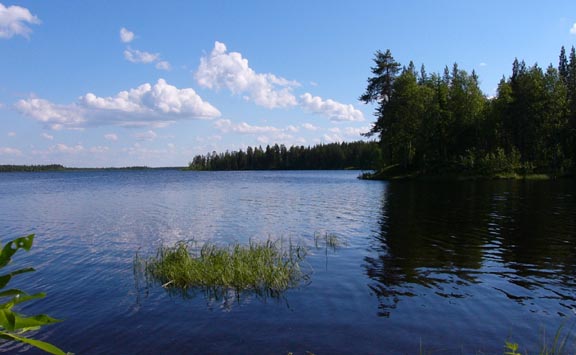
We would go from a big-tree forest
into a
long stretch of
scrub forest with no noticeable change in altitude or exposure or
anything else
to easily explain the difference. It may have just been stages in the
evolution
of soil sufficient for plant life because this area was under thousands
of feet
of ice not too long ago, and was pretty well scraped down to bedrock.
The
bedrock is everywhere pretty close to the surface, even down in
southern
Finland where the trees and plants are very “civilized”
– but where naked black
rock juts up every so often to remind us how thin the skin of life is
on
earth….
The guidebooks we’d consulted
all
warned us to keep an eye
on gas gauges and kilometers between places, but we were almost
disappointed at
how settled the area really is. The petroleum culture is there in its
usual
strength, and except for the realization that the low-sounding prices
are for
liters rather than gallons, a gas station and convenience store in
Sapmi is
pretty much like a gas station and convenience store in the valley.
Our original destination above the
Arctic
Circle had been to
get to a place called Nordkapp, North Cape, which is the farthest point
of land
in Europe, nothing beyond but the Arctic Sea, sea ice and rocks, and
the North
Pole. But we ran into a couple of tire salesmen in our hotel who, in
addition
to reacquainting us with akva vit (that’s probably not spelled
right but akva
vit makes you not care), told us that Nordkapp is a big ripoff –
busloads of
tourists are taken there, there’s a hefty toll (about $25 per
person), and it
has essentially been turned into the Pike’s Peak of the far north
– the world’s
northernmost parking lot.
A closer look at a guidebook
essentially
confirmed what they
said, so when we headed north the next morning – after a visit to
the Sami
Museum run by the Sami and the beautiful Sami Parliament building - we traveled on the main road with the buses
for a while, but then found a less-traveled road that went up the other
side of
the Porsanger Penninsula from the side that ends at Nordkapp. What we
found was
a windward coast of dark rock and lichen and small tough plants that
was just a
raw wildness with a narrow road running along the edge of it. On a
partly
cloudy, partly sunny afternoon, with a wind blowing in from somewhere
colder,
it was a place that transcended the idea of “beautiful.” A
great place to visit
but you wouldn’t want to live there – although, at the
upper end of the sound,
there were several pastoral farms, with sheep, not reindeer. On that
summer
day, with a wind that forced one to keep a jacket on, it was possible
to
imagine what it must be like there when, rather than a sun that never
drops
below the horizon, the people go through months when the sun never
rises above
the horizon, and snow rides in on the wind that never stopped that
afternoon. Two pictures:
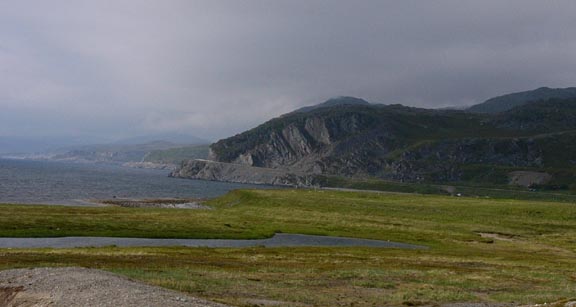

We were surprised to find fairly
serious
mountains up there
in the far north – mountains that rose about as far above the
surrounding
countryside (close to sea level) as Crested Butte Mountain rises above
its
valley. Even our discovered coast had several hundred feet of pretty
steep
terrain rising away from it. It was, all told, a land of what I would
call cool
splendor. Big-sky country, green in its summer but with undertones of
gray
winter as close as a cloud over the sun. This picture shows the
mountain landscape....
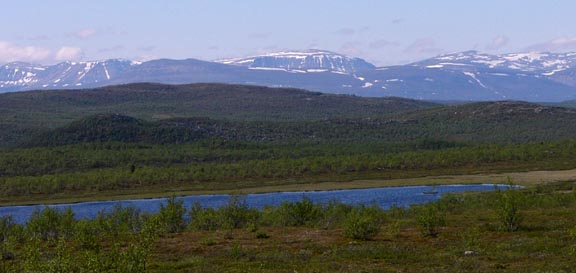
We found Sapmi and its Sami people to
be in an interesting cultural juxtaposition. They are still "the people
of the reindeer" - but they are also a modern global-tourism culture.
They live in modern houses in landscapes not unlike the American
landscapes of the Midwest; they use pickup trucks, ATVs and snowmobiles
to work the reindeer. And they are as globally connected as we are; our
guide at the Sami Parliament building is a medical student at the
University of Lappland, and lamented the fact that the nearby airport
doesn't have wireless. Our guide at the Sami outdoor museum had
lace-trimmed lycra leggings peeping out from under the traditional
dress we suspected she just wore on the job. We didn't ask about their
television habits, but suspect the worst....
A word about roads in Finland
and far northern Norway.
They are definitely inferior to American roads – but probably not
so badly
inferior as our public transportation is inferior to theirs. Just as we
have
state and federal highways, they have national and
“European” highways – roads
with an “E” in front of their number. But all of them
– national highways and
E-highways – were fairly narrow, and had almost no shoulders.
Bicyclists – of
which we saw a few but not as many as I’d expected – really
had to ride a
tightrope to stay out of traffic without ending up in the borrow ditch.
Quite a
few of the roads we traveled had no line down the center, just dotted
lines
along the edges. We interpreted this to mean – correctly, I think
– that the
road was not really wide enough for two lanes, so no sense in putting
in a
center line, and let the fittest survive. These roads were posted as 70
kilometer-per-hour roads
(~40 mph),
but people seemed to drive them about 90 kph (~60 mph), and scootching
past
oncoming trucks was hard on the nerves of passengers.
Enough for now. Next, on to Stockholm,
Sweden, via a
floating-city ferry boat. A city that is like a living museum in some
respects, with a lot of museums that explain the city and rouse all
kinds of interesting questions....














